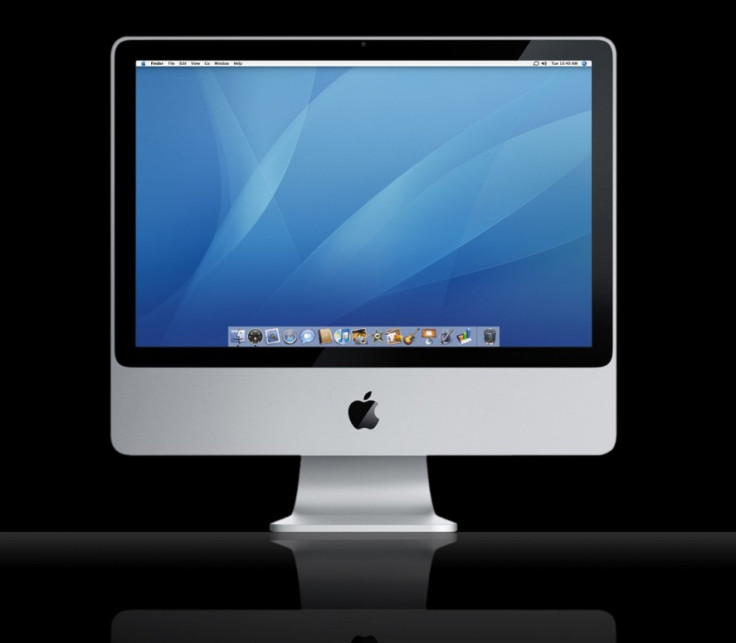iMac 2012 Release Rumors: Will Apple Refresh The Mac With Retina Display?
Analysis

The iMac has been one of the most iconic Apple computers -- from the translucent iMac G3 to the “sunflower” iMac G4 with the swiveling monitor -- yet it has been about three years since Apple has actually performed a redesign on the iMac. That may finally change at Apple’s scheduled media event set for Tuesday, which will reportedly introduce a completely redesigned iMac, among several other Mac and iOS devices, including a 13-inch MacBook Pro with Retina Display, a newly updated Mac Mini computer and an all-new 7.85-inch iPad, also known as the iPad Mini.
On Oct. 14, a WeiPhone.com user, who claimed to have a brother-in-law working in the factory building the new Mac computers, posted cell phone images of an iMac with a redesigned screen on the site’s forum, calling the “teardrop-shaped” design “revolutionary.” The poster compared the iMac to a drop of water with “tetragonal elements” -- even though the new computer reportedly still has that trademark “chin” below the display -- and added that, from side to side, you “almost cannot see the new iMac’s thickness.”
These alleged design changes are very exciting to read about, but what about the display? Will it feature the same high-resolution LED screen from the current model, or will Apple implant its biggest Retina Display yet into the all-new 2012 iMac?
Why The 2012 iMac Will Have A Retina Display
One of the most important aspects of the new iMac noted by the WeiPhone.com user was its “expensive” display. According to the post, the new iMac’s display features a “very pretty special glass glued directly” to the computer, rather than in past iterations of the iMac, where the display was manufactured separately from the machine.
The new iMac’s design has since been verified by the repair experts at iFixit, who said the internals shown in the photos are similar to the current iMac with the plastic radio-transparent circle on the back.
This design feature -- gluing the screen directly to the front panel -- was the same process used to create the Retina Displays in the third-generation iPad released this March and the 15-inch MacBook Pro with Retina Display released this June. As a result, both of those devices received low-reparability ratings from iFixit: the iPad "3" received a score of 2 out of 10, with “10” being easiest to repair, while the 15-inch Retina Macbook earned a paltry 1 out of 10.
“The display assembly is completely fused, and there’s no glass protecting it,” iFixit wrote in its assessment of the 15-inch Retina MacBook Pro. “If anything ever fails inside the display, you will need to replace the entire extremely expensive assembly.”
Solely gleaning from the manufacturing process used to build this screen, it’s possible the new iMac’s screen is a Retina Display.
Why The 2012 iMac Won’t Have A Retina Display
The last generation of iMacs had big, beautiful, high-resolution LED screens. The 21.5-inch iMac featured a display resolution of 1920 x 1080 pixels, while the larger 27-inch model featured a much denser resolution of 2560 x 1440 pixels. According to KGI Securities analyst Ming-Chi Kuo, who has a reliable track record when it comes to predicting the features and release dates of Apple products, said that the new 21.5-inch and 27-inch iMacs will not feature a Retina Display but will “still prove attractive to customers” thanks to a newly improved “full-lamination process” to attach the display panel to the protective cover glass, which reportedly improves the display quality on the Mac.
In the third-generation iPad, Apple proved it can create Retina Displays for devices bigger than an iPhone. That 9.7-inch iPad had a pixel resolution of 2048x1536 -- almost the same resolution as the 27-inch iMac in a device one-third the size. Whether or not Apple wants a Retina Display in its iMacs, the process to build one may be more expensive and complicated than any other display the company has ever built, and it may not be worth the investment in this generation of iMacs.
If Apple wanted to give the iMac a Retina Display, the company would have to bump the pixel density of the 21.5-inch model to 3840x2160, but a Retina Display on a 27-inch iMac would require a 5120x2880 pixel resolution. This would be an absolutely monstrous display, but it could create more problems than benefits, especially when it comes to overheating or even handling the intensely dense resolution on a daily basis.
Software developer David Barnard, founder of App Cubby, argued in March that Apple could stil improve the Mac displays without actually quadrupling the number of pixels on the desktop workspace, explaining that even a 27-inch iMac with a 3840x2400 resolution would still manage to include a "Retina" workspace of 1920x1200.
“The point is, PPI is much less relevant on OS X than on iOS,” Barnard wrote on the App Cubby blog. “To create Retina Displays, Apple doesn't have to build displays that are exactly 2X current displays; they just have to build displays that work well with OS X when running @2X.”
While Apple would jump at any chance to add the “Retina” moniker to any of its devices, the simple fact of the matter is while Apple could give the iMac a Retina Display, it might not need to Retina-ize the entire computer to enjoy the same “Retina” experience.
According to an old benchmark from Geekbench makers Primate Labs, the new iMac, described as “iMac 13,2” internally, reportedly runs on a 3.4 GHz Core i7-3770 quad-core processor with 4GB of 1600 MHz RAM and is powered by the OS X Mountain Lion operating system. In August, Kuo released his own product launch schedule, pegging the release of a new iMac in mid-October.
© Copyright IBTimes 2024. All rights reserved.












